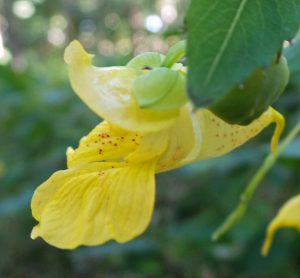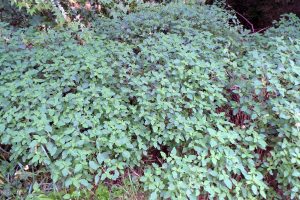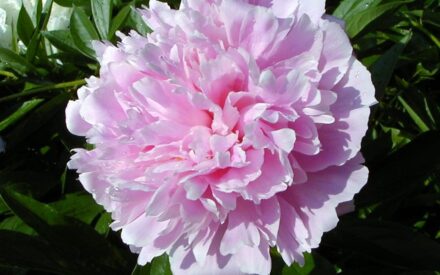
Jewelweed, Impatiens capensis, is an annual plant in the balsam family (Balsaminaceae) native to northern and eastern North America that also goes by other common names including orange balsam, orange jewelweed, spotted jewelweed, and spotted touch-me-not. The species name capensis, meaning “of the cape”, was applied because its origin was mistakenly thought to be from South Africa. It is common and widespread in moist, shady areas such as low woodlands, margins of bogs and marshes, along streams and lakes, in ditches, and in disturbed areas such as road cuts.

It is often found near the related but less common yellow jewelweed or touch-me-not, I. pallida, that is very similar but has larger yellow flowers with a shorter spur and tends to be a larger plant. It was taken to England, France, and other parts northern and central Europe in the 1800 and 1900’s where it naturalized readily and is quite similar to I. noli-tangere, native to Europe and Asia. Native Americans used the plant medicinally.
This self-seeding summer annual germinates in early spring and grows two to five feet tall by mid-summer from a shallow branching taproot. The somewhat weak, brittle stems are smooth, almost translucent and succulent and range in color from pale green to reddish green. Some plants have swollen or darkened nodes. The alternate, bluish-green leaves are oval-shaped with coarsely toothed margins for a scalloped appearance. Although they can get up to 5 inches long, the leaves are usually about 2½ to 3 inches long. Sparkling droplets of rain or dew beading up on the smooth leaves may be the source of the common name of jewelweed.

Jewelweed begins blooming in mid-summer and continues until the plant is killed by frost. The unscented, inch long flowers are bright orange to orange-yellow with variable amounts of red-orange spots and markings. Occasionally the flowers may be pale yellow to almost white, or may be unspotted. The two-lipped flowers have 5 petals (even though it looks superficially like only 3) and three sepals, with one sepal that is the same color as the petals modified into a large cornucopia-shaped pouch with a nectar spur at the back that curves underneath the rest of the flower. The upper lip is formed from one petal and there are two lateral petals, while the lower lip, with two fused petals, forms a landing pad for insect.

These solitary flowers, each hanging on its own slender stalk in a widely-spreading small cluster (raceme) of 1-3 in the axils of the upper leaves, are attractive to bumblebees and other long-tongued bees, butterflies, and hummingbirds (the main pollinators) and must be cross-pollinated to produce the elongated pendant green fruits (which are toxic if ingested). When ripe, the five-chambered capsule bursts explosively when touched as the spring-loaded sections of the capsule roll back into tight curled strips to forcibly eject and disperse the 4-5 green seeds (which is where the name ‘touch-me-not’ comes from). There may also be small, inconspicuous flowers produced in the fall at the bases of the leaves that fertilize themselves without ever opening (cleistogamous) and produce small seeds. These seeds produce much smaller plants than those from the large, showy flowers.


Jewelweed often forms large, dense stands and outcompetes many other plants – even the non-native invasive garlic mustard, Alliaria petiolata – when growing under optimal conditions. It can be a good addition to native plant gardens in moist, partially shaded areas or added to shady rain gardens. It can also be used to fill areas and suppress weeds and once established will continue to return every year. Jewelweed grows best in moist, humusy soil in partial to full shade, especially along the margins of water.
While jewelweed generally has few pest problems, deer will browse the foliage, while mice and many ground birds eat the seeds.
– Susan Mahr, University of Wisconsin – Madison
Latest Horticulture News
Ask Your Gardening Question
If you’re unable to find the information you need, please submit your gardening question here:





 Alternatives to Lawn: Groundcovers
Alternatives to Lawn: Groundcovers Marigolds
Marigolds Peony
Peony Iris Severe Mosaic
Iris Severe Mosaic


